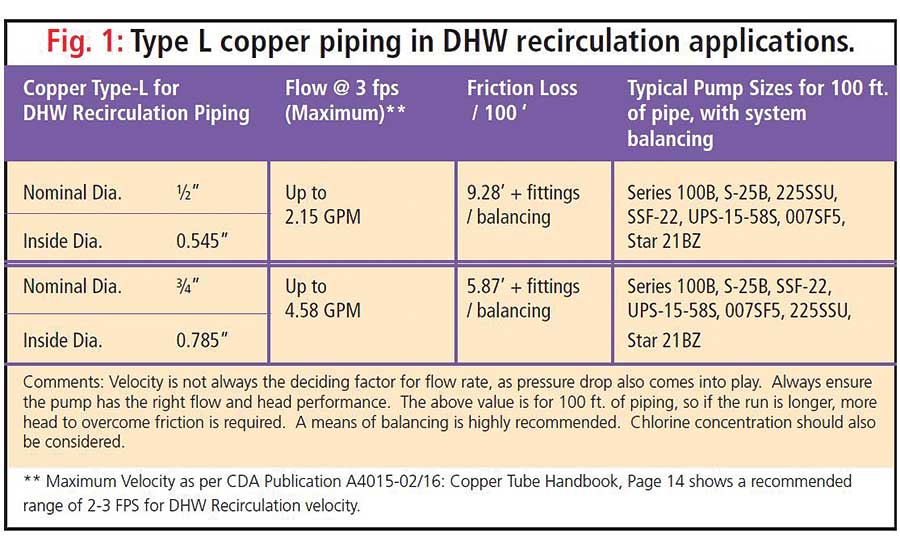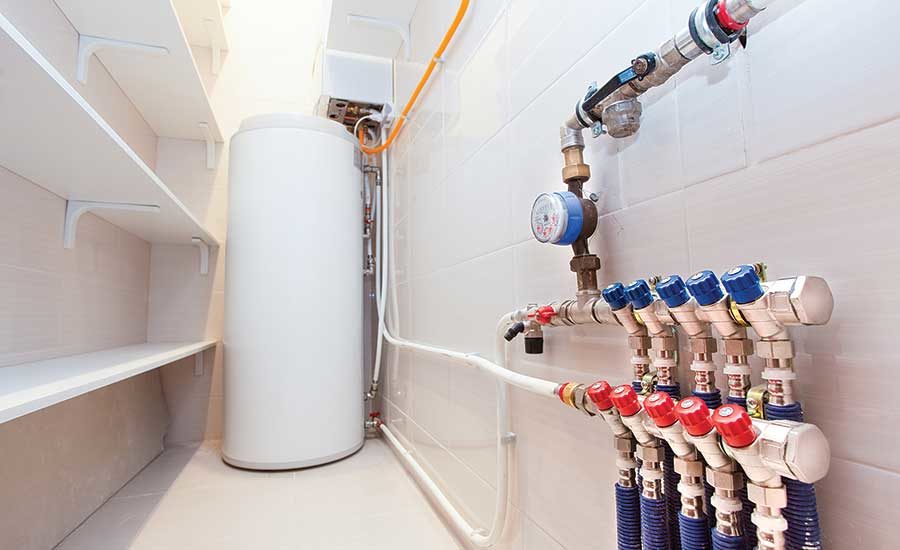Commercial applications continue to include domestic hot-water return or recirculation lines as a best practice. Over the past few years, DHWR lines have become popular in residential applications as well.
Adding a return line to the domestic hot-water system creates a closed-loop path that allows the water to circulate back to the water-heating source to keep the lines warm when fixtures and other loads are not in use. DHWR piping provides hot water to the various loads in the system very quickly upon demand — even if the hot water has not been required for a long period of time.
It’s as if the DHWR system has been placed on “idle,” waiting to accelerate into action with system water pressure behind it. When all hot water taps/loads are closed, the loop is pressurized/equalized to the system water pressure, therefore a pump is needed to move the water (creating a difference in pressure) from the loads and back to the heat source to keep it at its “idling” temperature — ready to spring into use.
This recirculation concept has many benefits; the primary one being less water energy is consumed overall. Eliminating the frustrating wait for warm water at the tap or shower means less water lost down the drain. Where drains are metered, this reduction in wasted water also can save money.
That is why DHWR is considered a plumbing design “best practice” and, as you would expect, there are guidelines that help with good design. ASPE has a procedure in its design manual on domestic water systems that shows how to calculate the required DHW recirculation flow rates based on the BTU losses of these “closed” loops.
Pump-sizing considerations
Important pump-sizing considerations sometimes are set aside in favor of rules of thumb that could be inaccurate. I have spent a great deal of time in the pump world where many times I would simply send a quote for the bronze pump that appeared on the schedule, for which — or so I believed — all the work and thought behind the selection had been completed.
Admittedly, I didn’t spend a lot of time thinking about DHWR pump sizing, either; yet now I am starting to see the end results of oversized pumps on DHWR lines in all types of tubing materials. Sized correctly, a recirculation pump will be as small as possible to keep the recirculated water at the design temperature.
If the pump is undersized, recirculated hot water will not stay warm enough. Too little flow would not allow the water to maintain its temperature because the heat losses in the line would exceed the heat replenishment rate or create an inability to reheat the water fast enough.
Too large a pump can result in higher purchase costs. These pumps need to be constructed of nonferrous materials (bronze and stainless steel are common), so too large a pump can be very expensive in comparison to a smaller unit that will do the job just fine.
Larger motor sizes also play a role in cost if single-phase power is the only available feed. Too much flow (high velocity) has the potential for much more sinister repercussions to the system. I use the word “sinister” because these problems are often hidden from us until there is a failure — especially if the chlorine content of the system is higher than needed.
Keep in mind DHWR lines are insulated and post-installation inspections would not happen often, if at all.
Adding a smart pump
With their ability to sense temperature, smart pumps can boost overall system efficiency in two ways:
∎ Reduced motor power consumed to circulate the water; and
∎ Reduced controls cost since temperature-sensing controls are integrated. Properly programmed and sized, smart pumps truly can optimize a DHWR system.
Based on the importance of these sizing/selection issues, I believe every technician and designer needs to be keenly aware of what the oversizing issues are and what needs to be done about them if they are re-piping a failed system — or upsizing a smaller pump to the right model.
Be aware of the pump/piping network combination for early warning signs of oversized pumps; as well as where the inconvenience of an undersized pump will surface in complaints without potential system damage. Make it a goal to take into account the combination of the pump being integrated with the piping network on any system you are asked to design and install.
The piping network
Now that we have covered the pump issues around flow, we can involve the piping network in the equation. We use piping all the time to get water from one location to another, but we need to be aware that domestic hot water is fresh (with entrained oxygen) and does not go through an air separator while circulating.
The combination of relatively hot water, the presence of chlorine and entrained air can have a scouring effect that is amplified at high velocity. Ends and elbows take the brunt of the punishment from changes in direction of the water, but experience tells us most mechanical failures are random. We can only control the primary operational environment not where the failures will ultimately show up.
The tables in Figure 1 (Type L copper piping systems) and Figure 2 (PEX systems) give some guidance on DHWR systems with regard to how the pieces of the puzzle fit together.


∎ For existing systems, does the pump seem too large?
∎ For systems being designed, do the pumps seem to be oversized/undersized?
Further to these piping fact charts, another chart could be developed using pressure drops at various flow rates per 100 ft. in a 1/2-in. line, a 3/4-in. line, a 1-in. line, etc. This chart could show how certain pump sizes fit, thus serving as a good beginning reference point for installers and troubleshooters.
Sizing summary
We can summarize DHW recirculation system sizing as follows:
∎ Btu loss sizing would be considered a preferred method as the rationale behind recirculation is to offset the Btu/h losses in the loop. More flow is not necessarily better.
∎ In the real world, the best-practice application for existing piping networks with missing information can be a difficult and time-consuming venture — and could require additional engineering support.
∎ For identified trouble locations, use circuit-balancing valves and/or augment the use of balancers with “smart” replacement-line sizing to equalize pressure drops in loops to limit velocities.
∎ Be sure to account for Btu. PEX tubing will hold less water volume than copper for the same size and that will come into the equation for Btu losses in this type of system.
∎ There are many pitfalls in using larger pumps than required, as increased velocity to the system — and the initial cost of the pump — are factors to consider. It is best to apply the pump after system water volumes, furthest fixture lengths/pressure drops and anticipated Btu losses are analyzed. Pumps continually operating close to shutoff head tend to experience more bearing thrust, which may affect lifespan.
I believe it is better to ask more questions about a DHWR system like this during the design phase and verify the answers than to install the system, only to have problems later. Leaking systems can cause a great deal of expensive damage that could be avoided with good design and foresight.





